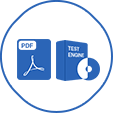Last Update 20 hours ago Total Questions : 126
The Certified Psychiatric Rehabilitation Practitioner content is now fully updated, with all current exam questions added 20 hours ago. Deciding to include CPRP practice exam questions in your study plan goes far beyond basic test preparation.
You'll find that our CPRP exam questions frequently feature detailed scenarios and practical problem-solving exercises that directly mirror industry challenges. Engaging with these CPRP sample sets allows you to effectively manage your time and pace yourself, giving you the ability to finish any Certified Psychiatric Rehabilitation Practitioner practice test comfortably within the allotted time.
Sharing personal recovery stories is important because they
An individual's treatment team is divided regarding her decision to work a full-time job. Part of the team is supportive of the idea. Others feel that the stress will be too much and will cause her to become symptomatic. The IPS model of supported employment would encourage the practitioner to assist her with
An individual is working on setting an overall rehabilitation plan with her practitioner. One of the objectives is to return to college to finish her degree in accounting, but she wants to work on other objectives first. This person is MOST likely in what stage of change?
Which of the following factors BEST contributes to wellness among individuals with psychiatric disabilities?
An individual has been using the bus to get to work, but weekend service has been eliminated. He works every other Saturday. He and the practitioner research possible options including riding with co-workers. This strategy is an example of
Which of the following best reflects key elements of recovery?
An individual describes sadness due to the death of a loved one. The best first response to the individual is:

